TRADISI MIPIT PARE DALAM BINGKAI LIVING QUR'AN DI PANDEGLANG BANTEN
DOI:
https://doi.org/10.32678/alfath.v16i2.9667Kata Kunci:
Masyarakat, Tradisi, Mipit Pare, Al-Qur'anAbstrak
Manusia dianjurkan berikhtiar untuk mendapatkan sesuatu yaitu dengan berusaha dan berdoa semaksimal mungkin, begitupun dengan masyarakat Kampung Kacapi Desa Kutamekar menjadikan tradisi mipit pare sebagai bagian dari bentuk dari ikhtiar dan doa yang dilakukan untuk tercapainya panen yang diharapkan serta sebagai tanda syukur kepada Allah atas keberhasilan masa tanam padi. Tradisi mipit pare dilakukan sebelum pelaksanaan panen, dengan pembacaan ayat-ayat pilihan dan doa Nurbuat. Tradisi ini dilakukan dengan tujuan agar panennya terhindar dari segala macam hal buruk, meminta kepada Allah agar panennya mendapat keberkahan, dan sebagai tanda syukur karena Allah telah memberikan rezeki kepada para petani dengan menumbuhkan padi-padi mereka sehingga padi-padi mereka dapat dipanen. Skripsi ini berusaha melihat dan menganalisis fenomena yang dilakukan masyarakat Kampung Kacapi yang menjadikan tradisi mipit pare sebagai bentuk doa dan syukur kepada Allah. Penulis menggunakan metode penelitian Living Qur'an yaitu penelitian ilmiah tentang berbagai peristiwa sosial terkait dengan kehadiran Al-Qur'an di masyarakat muslim tertentu. Adapun pendekatan yang digunakan penulis adalah pendekatan fenomenologis.
Unduhan
Referensi
al-Marāgī, Aḥmad Muṣṭafā.Tafsir Al-Maraghi, trans. Bahrun Abu Bakar, dkk. Semarang: CV. Toha Putra, 1986.
Anti, “Proses Pelaksanaan Tradisi Mipit Pare,” interview by Nina Maharani, December 17, 2021.
Arikunto, Suharsimi. Prosedur Penulisan: Suatu Pendekatan Praktik. Jakarta: PT. Rineka Cipta, 1993.
Basri, Asrul, dkk. Mengenal Tradisi Bercocok Tanam di Indonesia. Jakarta: Museum Nasional, 2001.
Chodjim, Ahmad. Al-Fatihah Membuka Mata Batin dengan Surah Pembuka (Jakarta: PT. Serambi Ilmu Semesta, 2000.
Departemen Agama RI, Al-Qur’an Dan Terjemahnya (Jakarta: Yayasan Penyelenggara Terjemah Al-Quran, 2009), p. 146.
Departemen Agama RI, Al-Qur’an Dan Terjemahnya, p. 1.
Eldeeb, Ibrahim. Be A Living Quran: Petunjuk Praktis Penerapan Ayat-Ayat Al-Qur’an Dalam Kehidupan Sehari-Hari. Jakarta: Lentera Hati, 2009.
Hamka. Tafsir Al-Azhar (Jakarta: Pustaka Panjimas, 1982.
Hasbillah, Ahmad ‘Ubaydi. Ilmu Living Qur’an-Hadis. Ciputat: Maktabah Darus Sunnah, 2019.
Marsikah, “Proses Pelaksanaan Tradisi Mipit Pare,” interview by Nina Maharani, December 17, 2021.
Masta, “Landasan Pelaksanaan Tradisi Mipit Pare,” interview by Nina Maharani, December 20, 2021.
Misna, “Sejarah Tradisi Mipit Pare,” interview by Nina Maharani, December 18, 2021.
Misna. “Tradisi Mipit Pare,” interview by Nina Maharani, December 17, 2021.
Moleong, Lexy J. Metodologi Penelitian Kualitatif. Bandung: PT. Remaja Rosdakarya, 2016.
Ruminah, “Pengertian Mipit Pare,” interview by Nina Maharani, December 17, 2021.
Ruminah, “Sejarah Tradisi Mipit Pare,” interview by Nina Maharani, December 17, 2021.
Sadiah, “Landasan Pelaksanaan Tradisi Mipit Pare,” interview by Nina Maharani, December 20, 2021.
Sahali, “Sejarah Tradisi Mipit Pare,” interview by Nina Maharani, December 17, 2021.
Shihab, M. Quraish. Al-Lubab: Makna, Tujuan, dan Pelajaran dari Al-Fatihah dan Juz ’Amma (Jakarta: Lentera Hati, 2008), p. 7-8.
Shihab, M. Quraish. Tafsir Al-Misbah: Pesan, Kesan Dan Keserasian Al-Qur’an. Jakarta: Lentera Hati, 2001.
Simanjuntak, Bungaran Antonius. Tradisi, Agama, dan Akseptasi Modernisasi Pada Masyarakat Pedesaan Jawa. Jakarta: Yayasan Pustaka Obor Indonesia, 2016.
Windha Astuty M, “Tradisi Mappatettong Bola,” in Riset Budaya: Mempertahankan Tradisi di Tengah Krisis Moralitas, ed. Muhammad Qadaruddin Abdullah. Parepare: IAIN Parepare Nusantara Press, 2020.
Yusuf, Muhammad. “Pendekatan Sosiologi dalam Penelitian Living Qur’an,” in Metode Penelitian Living Qur’an dan Hadis, ed. Sahiron Syamsuddin. Yogyakarta: TERAS, 2007.
##submission.downloads##
Diterbitkan
Cara Mengutip
Terbitan
Bagian
Lisensi
Hak Cipta (c) 2023 Nina Maharani

Artikel ini berlisensiCreative Commons Attribution-ShareAlike 4.0 International License.
Copyright Notice

Al-Fath: http://jurnal.uinbanten.ac.id/ is licensed under a Creative Commons Attribution-ShareAlike 4.0 International License
An author who publishes in Al-Fath agrees to the following terms:
- Author retains the copyright and grants the journal the right of first publication of the work simultaneously licensed under the Creative Commons Attribution-ShareAlike 4.0 License that allows others to share the work with an acknowledgment of the work's authorship and initial publication in this journal
- Author is able to enter into separate, additional contractual arrangements for the non-exclusive distribution of the journal's published version of the work (e.g., post it to an institutional repository or publish it in a book) with the acknowledgment of its initial publication in this journal.
- Author is permitted and encouraged to post his/her work online (e.g., in institutional repositories or on their website) prior to and during the submission process, as it can lead to productive exchanges, as well as earlier and greater citation of the published work (See The Effect of Open Access).
Privacy Statement
The names and email addresses entered in this journal site will be used exclusively for the stated purposes of this journal and will not be made available for any other purpose or to any other party.










